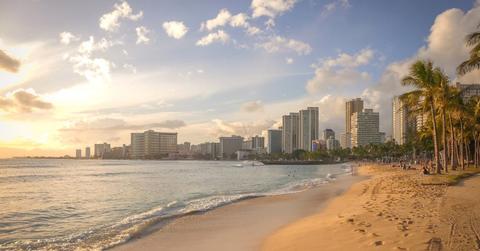Hawaii Commits To 100% Renewable Roads By 2045
Hawaii is working hard to divorce its economy from imported fossil fuels. Local government is coming in to meet the state's needs with a commitment to renewable transportation.
Updated May 28 2019, 5:27 p.m. ET
Hawaii has announced a new commitment to sustainable living technology, declaring that the state will transform both private and public transportation to completely renewable fuel sources by 2045. Hōkūleʻa, the Polynesian Voyaging Society, hosted the state's four mayors from the City and County of Honolulu, Maui County, Hawaiʻi County and Kauaʻi County aboard a canoe in mid-December. There they signed proclamations declaring their goal.
Honolulu Mayor Kirk Caldwell, Maui County Mayor Alan Arakawa, Kauaʻi County Mayor Bernard P. Carvalho Jr. and Hawaiʻi County Managing Director Wil Okabe (representing Mayor Harry Kim) met with Master Navigator Nainoa Thompson in Pōkaʻī Bay. Hōkūleʻa has special significance in regards to transportation.
Fast Company reports that the voyaging canoe made a highly publicized trip in June of 2017, using only traditional navigation tools to make their way around the world. The choice of location was a symbolic gesture to Hawaii's history.
“The stakes are too high for Oʻahu, as well as the rest of our state. We have to change our path,” Caldwell told reporters. “With this announcement we want to send a message that we welcome the next phase of Hawaiʻi’s clean energy transformation, which will not only reduce our carbon dioxide emissions and fossil fuel imports, but will also ensure a more resilient future.”
Caldwell also wrote in his post for Fast Company that the new commitment to renewable transportation was building on Hawaii's efforts towards sustainability.
Though the state has been working to green their grid, 24 percent of the state's fossil fuel consumption goes to ground transportation, and a quarter of their greenhouse gas emissions. Living on an island make the population even more aware of the threats posed by climate change and a rising ocean tide. Different sectors have been making commitments to combat these numbers for years.
Honolulu has already committed to making their bus system electric by 2035, and has one of the highest ridership rates in the nation. Maui and Kaua'i have also joined the pledge to improve their public transportation and switch to electric.
“It is vitally important that we chart a new course that steers us away from fossil fuel use and carbon emissions in our ground transportation,” said Maui Mayor Alan Arakawa. “The goals we are setting today are not only desirable, but attainable, and help send a message that Maui County and Hawaiʻi are open for innovation to help ensure the greater health of our communities and the planet as a whole.”
This band of mayors isn't coming out of nowhere. In 2015, Hawaii's governor signed four energy bills into law that set 2045 as the benchmark for when the state’s utilities must generate 100 percent of their electricity sales from renewable energy resources.
The decision was made to save money, cut off fossil fuel imports, and give folks who don't own their own homes a chance to save money on their electric bill. While overarching legislation is an important motivator in the fight against climate destruction, innovation often depends on the work of local government and businesses. Hawaii's mayors have heard the call, and are signaling their commitment to meet the state's goals, one bus ride at a time.
